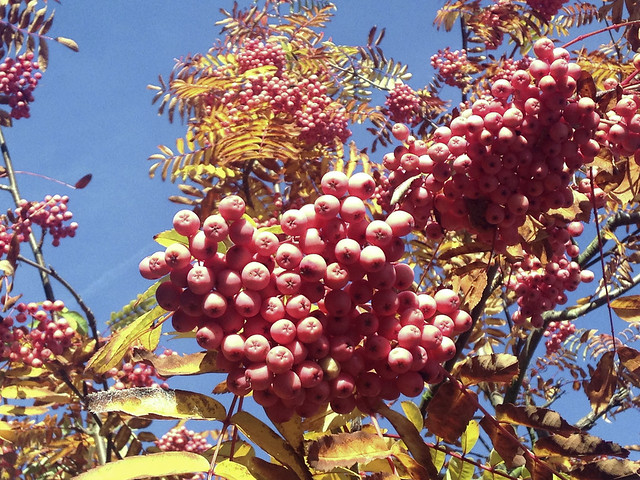I'm feeling rather pleased with myself and slightly uneasy at the same time. Why, you may ask. Let me tell you.
Having wanted to grow
proper quinces for several years, this year my tree has produced the goods. I counted 40 this year, a thrilling effort from this four year old tree. To have forty quinces gives plenty of scope for trying out new ways of cooking and preserving. But if there's this many this year, what of the future? I've read of massive gluts and that's when I start to get jittery. Forty I can cope with; eighty or more might start to feel like overwhelm. Do we really know what we want to do with a wealth of quinces? It's one of those 'Be careful what you wish for' moments.
My desire for a quince tree started in 2012 when I noticed the round fruits of
Chaenomeles x superba growing in the gardens at Capel Manor where I was studying. I was told that they were edible, like quince. Seems reasonable as the plant's common name is Japanese Quince. I snaffled a few from the ground and made membrillo. It was jolly good.
I also used some to make a tea infusion. I'd heard that Lithuanians traditionally steep slices of raw quince in hot water and honey to make a soothing winter drink. Apparently the fruit is a good source of vitamin C, as well as copper, magnesium and other very useful minerals. I made some with Japanese Quince and was singularly unimpressed; it didn't taste of much. Obviously I needed
proper quinces for this. (Perhaps I should try again with one of this season's
Cydonia quinces.)
So why bother with
Cydonia (real) quince when you can use
Chaenomeles? Both have an aroma, although quince will perfume an entire room, and both have fruit that goes pink when cooked. I remember Japanese Quince (
Chaenomeles) being quite sharp flavoured, a bit like having lemon in tea so I'm going to guess that
Cydonia quinces are slightly sweeter, possibly with more depth of flavour. (Or maybe it's the other way round? Foraging might be in order when the rain stops. If anyone reading this knows, please tell!)
I'm having a bit of fun trying out various ways of using my quinces. After a weekend of rain, several of the fruit had split so were quickly picked and turned into a quince crumble using a Nigel Slater recipe from his fruit book 'Tender, vol II'. It was nice, in fact the topping was delicious, but it's not a patch on plum crumble!
(The online link to the Slater recipe is
here; make a note of the topping ingredients and enjoy Nigel's writing!)
After that, I was rooted in indecision for a while - there's more choice than just membrillo - but rediscovered this recipe for Old Fashioned Quince Jelly in my National Trust Preserves book. I had more split quinces that needed to be used quickly before they went brown and this recipe is one you just get on with. No peeling, coring or boring stuff. Just chop the quinces up, chuck into a pan, cover with water, cook, strain overnight, add sugar to the juice and boil.
The result is a beautiful clear jelly, sweet with a definite quince taste and scent. I had a enough left over for another half jar so have tried it out today on bread and butter; it's delicious. I like that its recommended uses are either for savoury (to go with lamb, cold meats, cheese, etc, like a redcurrant jelly) or topped with cream in a cake or, even better, spread on toasted muffins or scones! Now you're talking. Here's the finished result - four (and a half) little jars of deliciousness. Now where's my runcible spoon?
And I still have a bowl of quinces in the kitchen ... possibly for pickling.
Old Fashioned Quince Jelly
1.35kg (3lb) ripe quinces
Water to cover
Thinly pared rind and juice of 1 large lemon (unwaxed)
Granulated sugar
Wash the quinces, rub off any down. Don't peel or core them but chop roughly into a large pan and just cover with water. Add the lemon rind then simmer gently until the fruit is soft and pulpy (about an hour). Stir in the lemon juice and strain through a jelly bag overnight.
Next day, measure the juice and pour into a clean pan. Add warmed sugar (I put mine in the oven at 140°C for 10 minutes) allowing 450g to each 600ml juice. (I had 900ml juice so used 675g sugar - and, yes, I did
very gently squeeze the jelly bag to get the last of the juice from the pulp.)
Heat gently, stirring to completely dissolve the sugar, then bring to boil and boil rapidly until setting point is reached. 104°C if you have a sugar thermometer, or wrinkly spoonful on a cold plate if not.
Skim, then pot into hot/warm clean, sterilised jars, cover and seal. (I washed my jars, rinsed well and dried them in the oven after the sugar was warmed.)














